Detecting the Spatial Matching Relationship between Supply-Side and Demand-Side of Recreation Ecosystem Services (RES) from the Perspectives of Resource, Management, and Beneficiary: A Case Study in Yangmingshan National Park
Abstract
1. Introduction
2. Method
2.1. Study Site
2.2. Methods and Procedure
2.2.1. Spatial Quantification Unit
2.2.2. RES Supply Potential Assessment
Naturalness
Water Body
Relief and Presence of Summit
Landscape Diversity
2.2.3. Recreation Accessibility Assessment
Road Density
Distance from the Residence
2.2.4. RES Demand Potential and RES Flow Assessment
Questionnaire Design
RES Demand Potential Assessment
RES Flow Assessment
2.2.5. RES Match/Mismatch Detection
2.2.6. Overlay Analysis
3. Results
3.1. Statistical Results of the SAMPLES
3.1.1. Sample Composition
3.1.2. Recreation Participation Tendency and Actual Visits
3.2. Spatial Distributions of RES Supply-Side and Demand-Side
3.2.1. RES Supply Potential and Recreation Accessibility
3.2.2. RES Demand Potential and RES Flow
3.3. Spatial Distributions of RES Match/Mismatch
3.3.1. Classification of RES Match/Mismatch
3.3.2. Spatial Distributions of RES Match/Mismatch
3.4. Spatial Relationship between RES Match/Mismatch and RES Supply-Side
4. Discussion
4.1. Detecting from the Perspectives of Resource, Management, and Beneficiary
4.2. Application in Policy and Decision-Making
4.3. Limitations and Future Research Challenges
5. Conclusions
Supplementary Materials
Author Contributions
Funding
Conflicts of Interest
References
- Millennium Ecosystem Assessment Ecosystems and Human Well-Being: Synthesis; Island Press: Washington, DC, USA, 2005.
- Haines-Young, R.; Potschin, M. Common International Classification of Ecosystem Services (CICES) V5.1 and Guidance on the Application of the Revised Structure. Available online: https://cices.eu/resources/ (accessed on 20 December 2021).
- Haines-Young, R.; Potschin, M. The links between biodiversity 4493, ecosystem services and human well-being. In Ecosystem Ecology: A New Systhsis; Raffaelli, D., Frid, C., Eds.; Cambridge University Press: Cambridge, UK, 2010. [Google Scholar]
- Potschin-Young, M.; Haines-Young, R.; Görg, C.; Heink, U.; Jax, K.; Schleyer, C. Understanding the role of conceptual frameworks: Reading the ecosystem service cascade. Ecosyst. Serv. 2018, 29, 428–440. [Google Scholar] [CrossRef] [PubMed]
- Chang, H.C.; Lin, B.S. Ecosystem services of Yangmingshan National Park and their supply structures. J. Outdoor Recreat. Tour. 2020, 33, 1–33. [Google Scholar] [CrossRef]
- Doak, D.F.; Bakker, V.J.; Goldstein, B.E.; Hale, B. What is the future of conservation? Trends Ecol. Evol. 2015, 29, 77–81. [Google Scholar] [CrossRef] [PubMed]
- Schirpke, U.; Vigl, L.E.; Tasser, E.; Tappeiner, U. Analyzing Spatial Congruencies and Mismatches between Supply, Demand and Flow of Ecosystem Services and Sustainable Development. Sustainability 2019, 11, 2227. [Google Scholar] [CrossRef]
- Schulp, C.J.E.; Lautenbach, S.; Verburg, P.H. Quantifying and mapping ecosystem services: Demand and supply of pollination in the European Union. Ecol. Indic. 2014, 36, 131–141. [Google Scholar] [CrossRef]
- Kulczyk, S.; Woźniak, E.; Derek, M. Landscape, facilities and visitors: An integrated model of recreational ecosystem services. Ecosyst. Serv. 2018, 31, 491–501. [Google Scholar] [CrossRef]
- González-García, A.; Palomo, I.; González, J.A.; García-Díez, V.; García-Llorente, M.; Montes, C. Biodiversity and ecosystem services mapping: Can it reconcile urban and protected area planning? Sci. Total Environ. 2022, 803, 150048. [Google Scholar] [CrossRef]
- Small, N.; Munday, M.; Durance, I. The challenge of valuing ecosystem services that have no material benefits. Glob. Environ. Chang. 2017, 44, 57–67. [Google Scholar] [CrossRef]
- Hermes, J.; Berkel, D.V.; Burkhard, B.; Plieninger, T.; Fagerholm, N.; von Haaren, C.; Albert, C. Assessment and valuation of recreational ecosystem services of landscapes. Ecosyst. Serv. 2018, 31, 289–295. [Google Scholar] [CrossRef]
- Daniel, T.C.; Muhar, A.; Arnberger, A.; Aznar, O.; Boyd, J.W.; Chan, K.M.A.; Costanza, R.; Elmqvist, T.; Flint, C.G.; Gobster, P.H.; et al. Contributions of cultural services to the ecosystem services agenda. Proc. Natl. Acad. Sci. USA 2012, 109, 8812–8819. [Google Scholar] [CrossRef]
- Marion, J.L. A Review and Synthesis of Recreation Ecology Research Supporting Carrying Capacity and Visitor Use Management Decision making. J. For. 2016, 114, 339–351. [Google Scholar] [CrossRef]
- Zulian, G.; Paracchini, M.L.; Maes, J.; Liquate, C. ESTIMAP: Ecosystem Services Mapping at European Scale; Publications Office of the European Union: Luxembourg, 2013. [Google Scholar] [CrossRef]
- Peña, L.; Casado-Arzuaga, I.; Onaindia, M. Mapping recreation supply and demand using an ecological and social evaluation approach. Ecosyst. Serv. 2015, 13, 108–118. [Google Scholar] [CrossRef]
- Baró, F.; Palomo, I.; Zulian, G.; Vizcaino, P.; Haase, D.; Gómez-Baggethun, E. Mapping ecosystem service capacity, flow and demand for landscape and urban planning: A case study in the Barcelona metropolitan region. Land Use Policy 2016, 57, 405–417. [Google Scholar] [CrossRef]
- Lorilla, R.S.; Kalogirou, S.; Poirazidis, K.; Kefalas, G. Identifying spatial mismatches between the supply and demand of ecosystem services to achieve a sustainable management regime in the Ionian Islands (Western Greece). Land Use Policy 2019, 88, 104171. [Google Scholar] [CrossRef]
- González-García, A.; Palomo, I.; González, J.A.; López, C.A.; Montes, C. Quantifying spatial supply-demand mismatches in ecosystem services provides insights for land-use planning. Land Use Policy 2020, 94, 104493. [Google Scholar] [CrossRef]
- Driver, B.L.; Brown, P.J. The opportunity spectrum concept and behavioral information in outdoor recreation resource supply inventories: A rationale. In Integrated Inventories of Renewable Natural Resources: Proceedings of the Workshop; USDA Forest Service General Technical Report RM-1978, 55; Rocky Mountain Forest and Range Experiment Station: Fort Collins, CO, USA, 1978. [Google Scholar]
- Lin, Y.J. Research on regional outdoor recreation resource planning methods: Discussion on the development strategy of recreation resources in Taiwan. City Plan. 1984, 11, 1–18. [Google Scholar]
- Pigram, J.J.; Jenkins, J.M. Outdoor Recreation Management, 2nd ed.; Routledge: London, UK, 2006. [Google Scholar]
- Smith, J.W.; Moore, R.L. Social-psychological factors influencing recreation demand: Evidence from two recreational rivers. Environ. Behav. 2012, 45, 821–850. [Google Scholar] [CrossRef]
- Fisher, B.; Turner, R.K.; Morling, P. Defining and classifying ecosystem services for decision making. Ecol. Econ. 2009, 68, 643–653. [Google Scholar] [CrossRef]
- Tourism Bureau of Taiwan Monthly Statistics of the Number of Tourists in the Main Tourist Destinations in Taiwan in 2018. Available online: https://admin.taiwan.net.tw/FileUploadCategoryListC003330.aspx?CategoryID=2638da16-f46c-429c-81f9-3687523da8eb&appname=FileUploadCategoryListC003330 (accessed on 25 February 2019).
- Stępniewska, M. Ecosystem Service Mapping and Assessment as a Support for Policy and Decision Making. Clean 2016, 44, 1414–1422. [Google Scholar] [CrossRef]
- Chen, J.H.; Lee, L.L.; Su, M.H.; Wu, S.P.; Lay, J.G.; Lee, C.T. The Interactions of Human Activities and Natural Resources around the Area Located at the North of Bailaka Highway and the West of Yangjin Highway in Yangmingshan National Park; Society for Wildlife and Nature: Taipei, Taiwan, 2011. [Google Scholar]
- Paracchini, M.L.; Zulian, G.; Kopperoinen, L.; Maes, J.; Schägner, J.P.; Termansen, M.; Zandersen, M.; Perez-Soba, M.; Scholefield, P.; Bidoglio, G. Mapping cultural ecosystem services: A framework to assess the potential for outdoor recreation across the EU. Ecol. Indic. 2014, 45, 371–385. [Google Scholar] [CrossRef]
- Ode, Å.; Fry, G.; Tveit, M.S.; Messager, P.; Miller, D. Indicators of perceived naturalness as drivers of landscape preference. J. Environ. Manag. 2009, 90, 375–383. [Google Scholar] [CrossRef] [PubMed]
- Kienast, F.; Degenhardt, B.; Weilenmann, B.; Wäger, Y.; Buchecker, M. A GIS-assisted mapping of landscape suitability for nearby recreation. Landsc. Urban Plan. 2012, 105, 385–399. [Google Scholar] [CrossRef]
- de Groot, R.S.; Alkemade, R.; Braat, L.; Hein, L.; Willemen, L. Challenges in integrating the concept of ecosystem services and values in landscape planning, management and decision making. Ecol. Complex. 2010, 7, 260–272. [Google Scholar] [CrossRef]
- Norton, L.R.; Inwood, H.; Crowe, A.; Baker, A. Trialling a method to quantify the ‘cultural services’ of the English landscape using Countryside Survey data. Land Use Policy 2012, 29, 449–455. [Google Scholar] [CrossRef]
- Rodrigue, J.; Comtois, C.; Slack, B. The Geography of Transport Systems, 2nd ed.; Routledge: London, UK, 2006. [Google Scholar]
- Ala-Hulkko, T.; Kotavaara, O.; Alahuhta, J.; Helle, P.; Hjort, J. Introducing accessibility analysis in mapping cultural ecosystem services. Ecol. Indic. 2016, 66, 416–427. [Google Scholar] [CrossRef]
- Maes, J.; Paracchini, M.L.; Zulian, G.; Dunbar, M.B.; Alkemade, R. Synergies and trade-offs between ecosystem service supply 4171, biodiversity, and habitat conservation status in Europe. Biol. Conserv. 2012, 155, 1–12. [Google Scholar] [CrossRef]
- Schipperijn, J.; Ekholm, O.; Stigsdotter, U.K.; Toftager, M.; Bentsen, P.; Kamper-Jørgensen, F.; Randrup, T.B. Factors influencing the use of green space: Results from a Danish national representative survey. Landsc. Urban Plan. 2010, 95, 130–137. [Google Scholar] [CrossRef]
- Weyland, F.; Laterra, P. Recreation potential assessment at large spatial scales: A method based in the ecosystem services approach and landscape metrics. Ecol. Indic. 2014, 39, 34–43. [Google Scholar] [CrossRef]
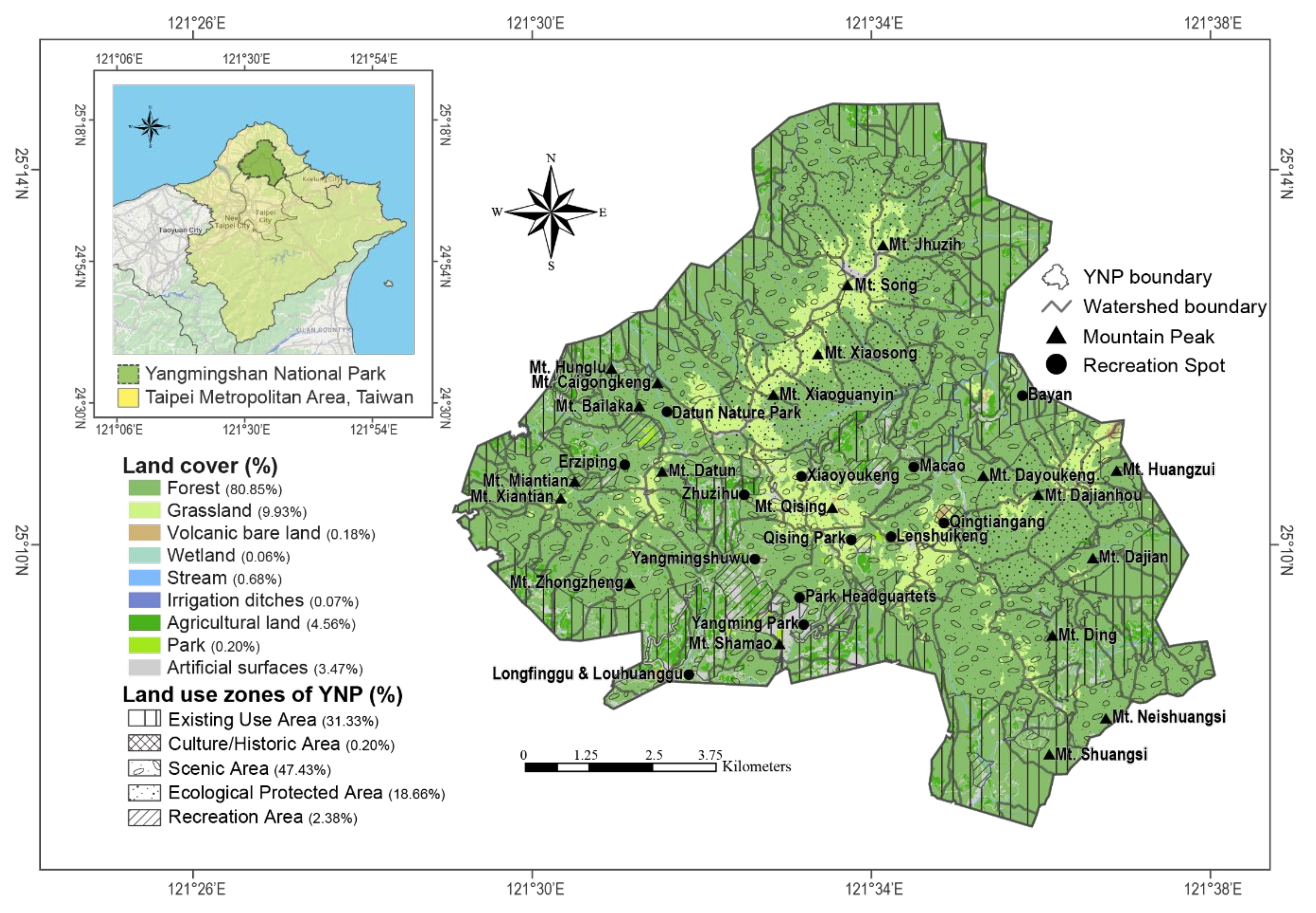
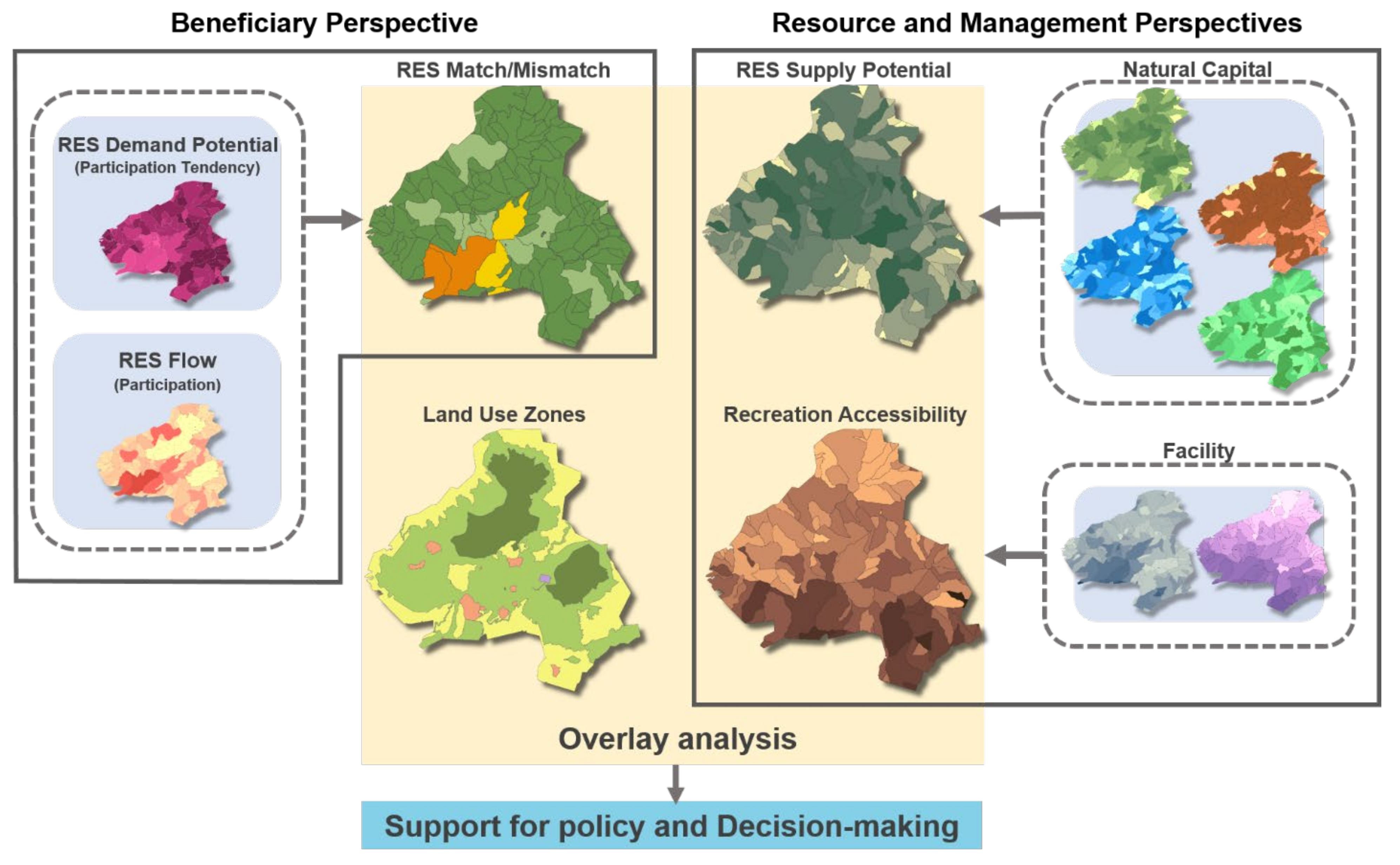
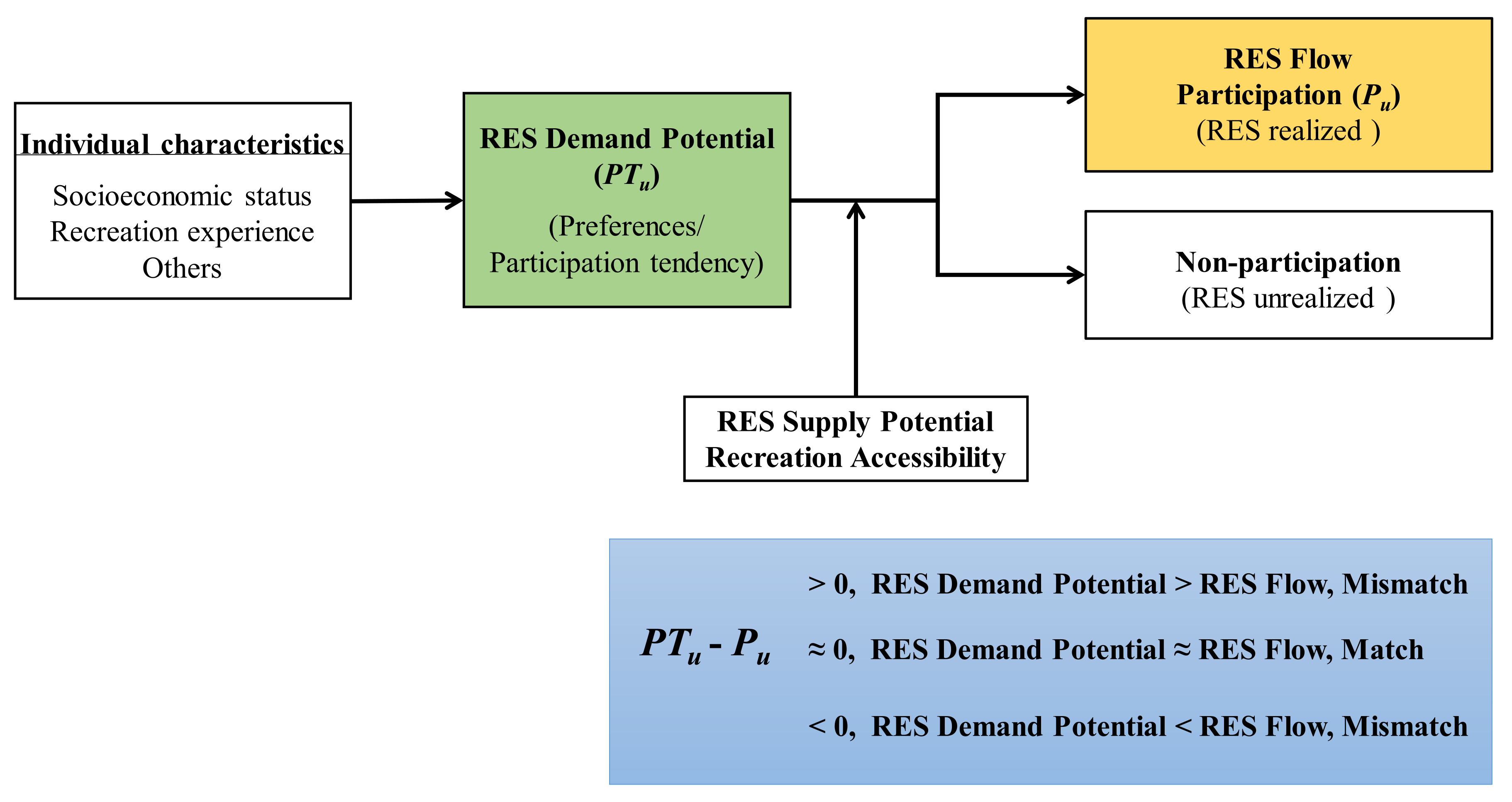
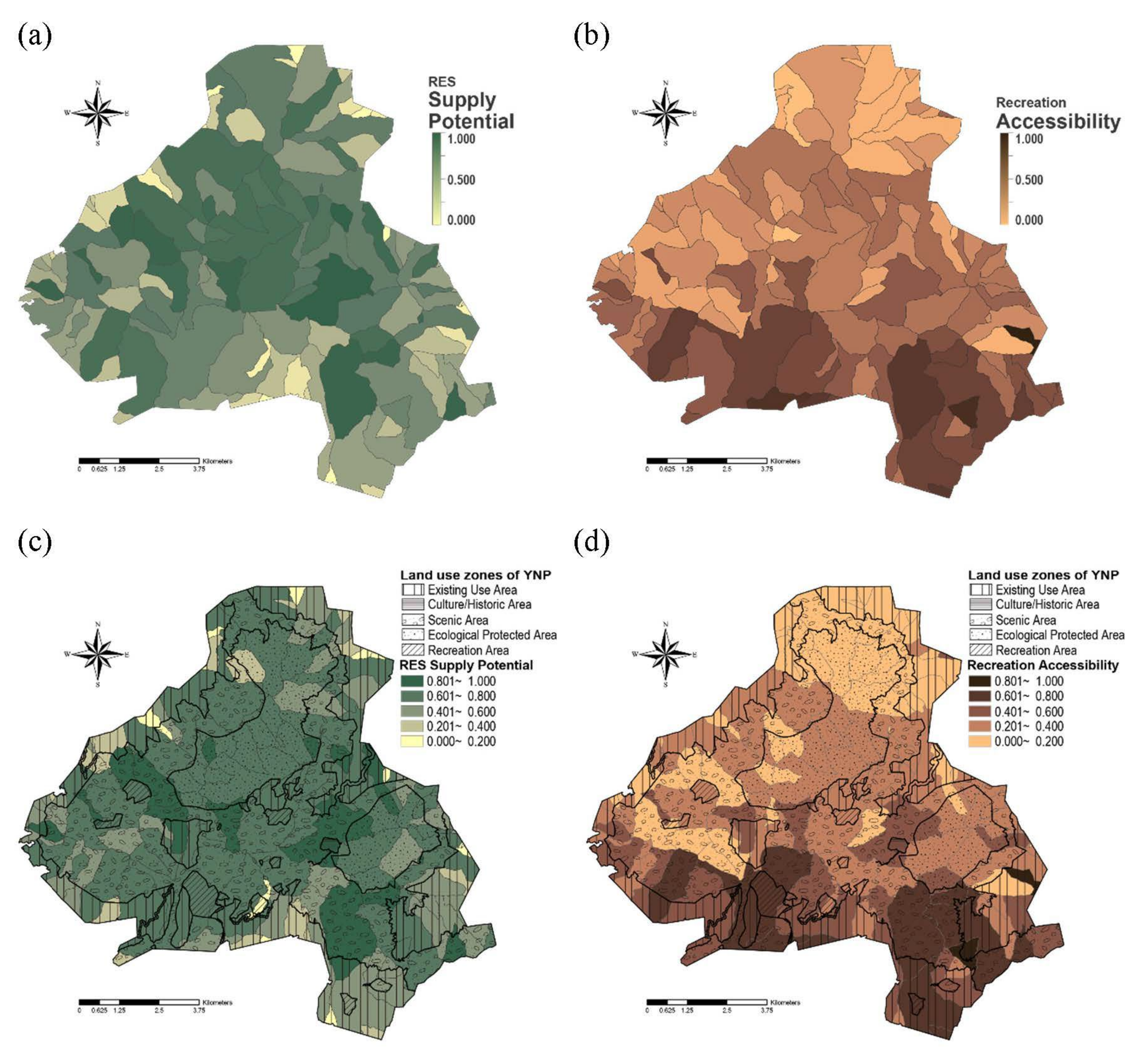
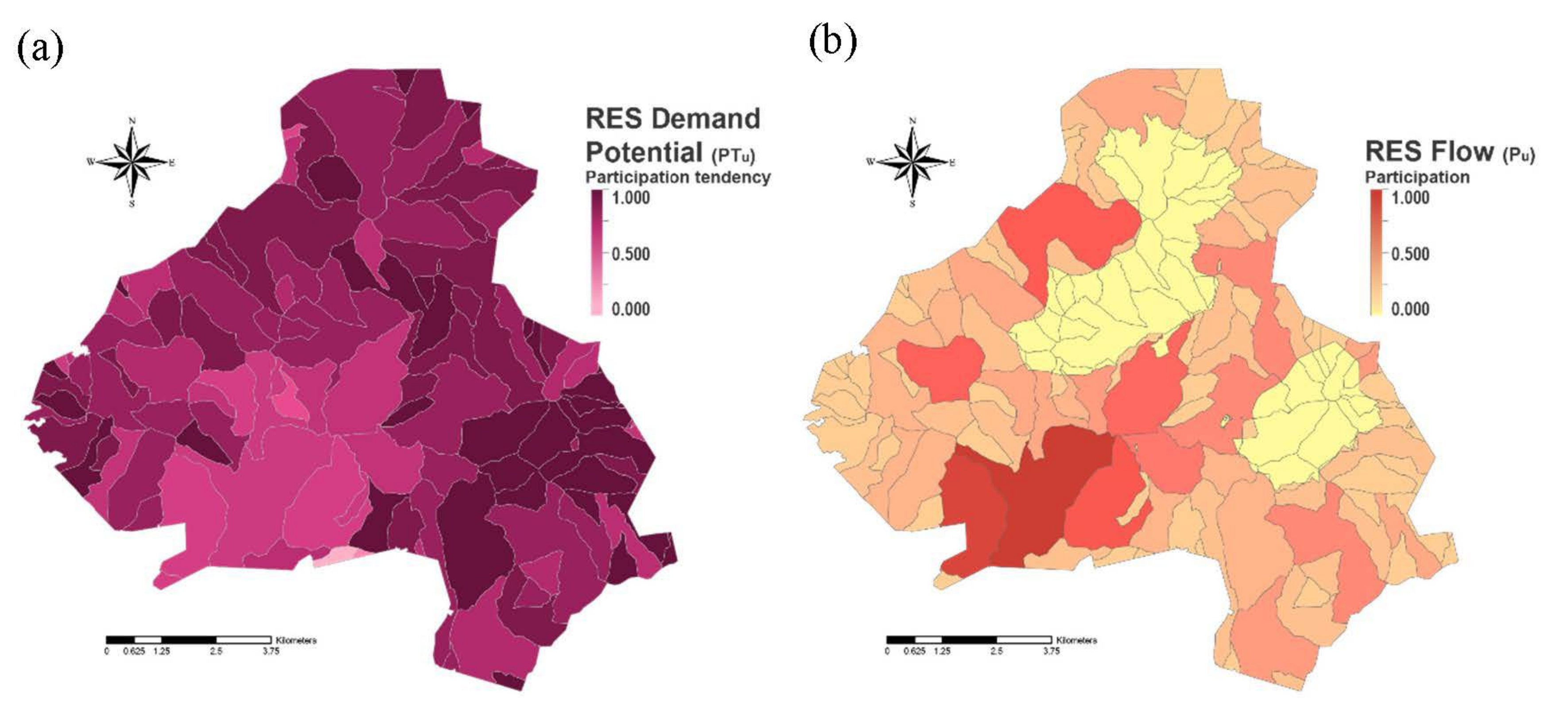
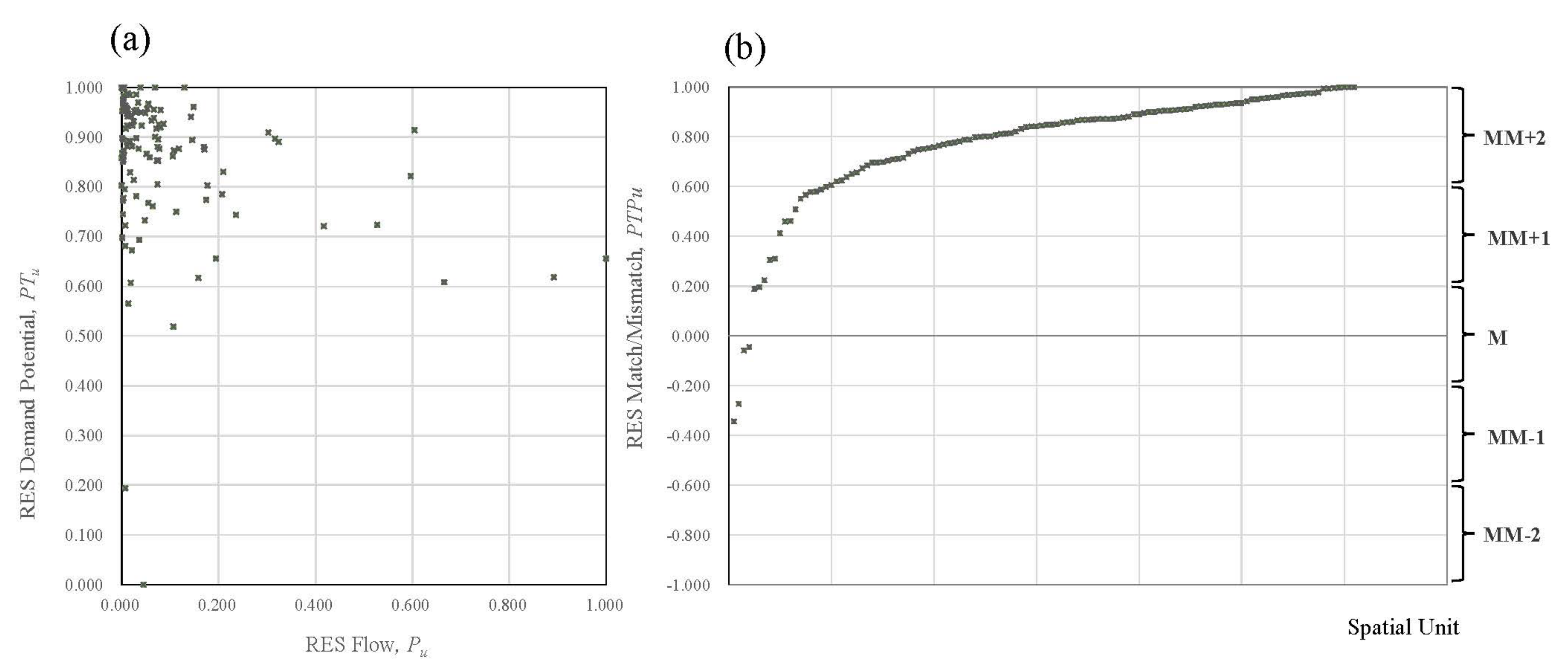

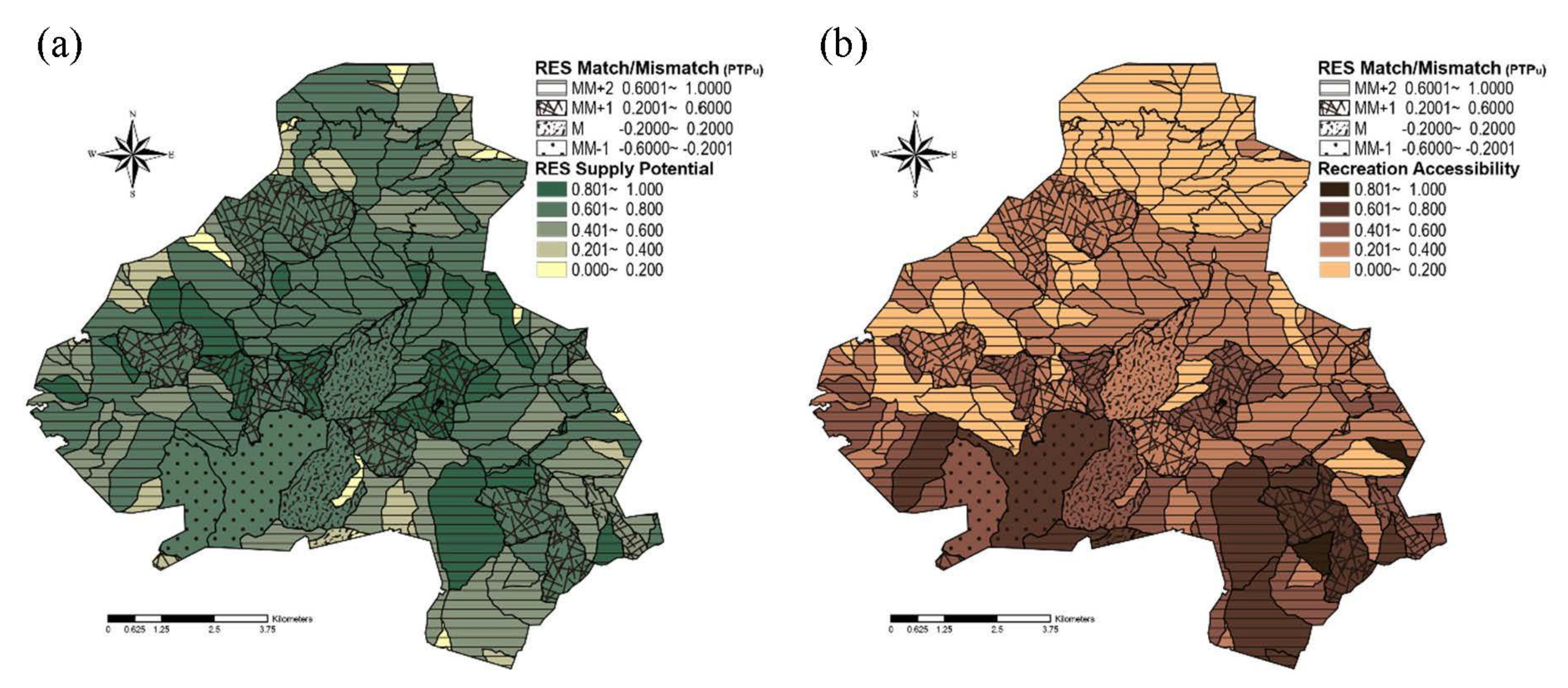
| Version | n | Mean | SD | t | p | |
|---|---|---|---|---|---|---|
| Recreation participation tendency toward forests | A | 317 | 7.9 | 1.96 | −0.939 | 0.348 |
| B | 317 | 8.1 | 1.84 | |||
| Number of visits to forests | A | 317 | 2.0 | 1.36 | 0.426 | 0.671 |
| B | 317 | 2.0 | 1.37 |
| Land Cover Type | Recreation Participation Tendency (PTCi) | Actual Visits | |
|---|---|---|---|
| (Mean ± SD) | Number of Visits | Percentage of Actual Visits (PLCi, %) | |
| Forests | 8.0 ± 1.90 | 402 | 15.1 |
| Grasslands | 7.6 ± 1.84 | 390 | 14.7 |
| Volcanic bare lands | 7.1 ± 2.04 | 253 | 9.5 |
| Wetlands | 6.7 ± 1.81 | 305 | 11.5 |
| Streams | 7.2 ± 2.03 | 224 | 8.4 |
| Irrigation ditches | 5.1 ± 2.48 | 254 | 9.6 |
| Agricultural lands | 6.6 ± 2.20 | 243 | 9.2 |
| Parks | 6.7 ± 1.73 | 341 | 12.8 |
| Artificial surfaces | 5.3 ± 2.47 | 245 | 9.2 |
| Total | 2657 | 100 | |
Publisher’s Note: MDPI stays neutral with regard to jurisdictional claims in published maps and institutional affiliations. |
© 2022 by the authors. Licensee MDPI, Basel, Switzerland. This article is an open access article distributed under the terms and conditions of the Creative Commons Attribution (CC BY) license (https://creativecommons.org/licenses/by/4.0/).
Share and Cite
Lin, B.-S.; Chang, H.-C. Detecting the Spatial Matching Relationship between Supply-Side and Demand-Side of Recreation Ecosystem Services (RES) from the Perspectives of Resource, Management, and Beneficiary: A Case Study in Yangmingshan National Park. Forests 2022, 13, 1849. https://doi.org/10.3390/f13111849
Lin B-S, Chang H-C. Detecting the Spatial Matching Relationship between Supply-Side and Demand-Side of Recreation Ecosystem Services (RES) from the Perspectives of Resource, Management, and Beneficiary: A Case Study in Yangmingshan National Park. Forests. 2022; 13(11):1849. https://doi.org/10.3390/f13111849
Chicago/Turabian StyleLin, Bau-Show, and Han-Chin Chang. 2022. "Detecting the Spatial Matching Relationship between Supply-Side and Demand-Side of Recreation Ecosystem Services (RES) from the Perspectives of Resource, Management, and Beneficiary: A Case Study in Yangmingshan National Park" Forests 13, no. 11: 1849. https://doi.org/10.3390/f13111849
APA StyleLin, B.-S., & Chang, H.-C. (2022). Detecting the Spatial Matching Relationship between Supply-Side and Demand-Side of Recreation Ecosystem Services (RES) from the Perspectives of Resource, Management, and Beneficiary: A Case Study in Yangmingshan National Park. Forests, 13(11), 1849. https://doi.org/10.3390/f13111849






